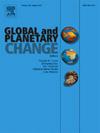Development of weakly euxinic basin environments in the Phanerozoic oxic ocean: Insights from Fe speciation and Mo isotopes of Devonian pyrite-bearing black shales, Dajiangping pyrite mine, South China
IF 4
1区 地球科学
Q1 GEOGRAPHY, PHYSICAL
引用次数: 0
Abstract
Although the Phanerozoic ocean was generally oxygenated, local euxinic events occurred frequently, as witnessed by the widespread Paleozoic sediment-hosted stratiform sulfide (SHSS) deposits. Here, we use redox-sensitive Fe speciation and Mo isotopes of black shales and pyrite ores of the Devonian Dajiangping stratiform pyrite deposit in the South China Block (SCB) to decipher the linkage between redox conditions, basin restrictions and SHSS mineralization. From bottom to top, the host sedimentary succession on the deposit margin is a transgressive sequence of siltstones, carbonaceous limestones and black shales. The ratios of highly reactive Fe to total Fe (FeHR/FeT: 0.29 to 1.0), Fe in pyrite to highly reactive Fe (Fepy/FeHR: 0.09 to 0.91), and δ98/95Mo (0.50 ‰ to 1.30 ‰), show consistently increasing trends upward throughout the stratigraphic sequence, indicative of changes in the redox of bottom seawater from oxic, through anoxic, to weakly euxinic, in response to the subsidence of the basin. Black shales and interlayered laminated pyrite ores on the deposit center have δ98/95Mo varying from +0.90 to +1.50 ‰ and higher than the host succession, clearly demonstrating the redox condition of bottom seawater in the depocenter is more euxinic than the margin of the basin. These δ98/95Mo values lower than those of seawater were resulted from the occurrence of thimolybdates with variable Mo isotopic fractionations in the weakly euxinc conditions. In addition, the positive correlation (R2 = 0.84) between Mo concentrations and total organic carbon (TOC) of the black shales suggests that Mo was authigenic in origin. These black shales have Mo/TOC of ∼1.7 ppm/wt%, which are much lower than those in poorly or unconfined euxinic basins (Mo/TOC > 11 ppm/wt%) and indicative of a restricted basin environment. The redox conditions of seawater changed from oxic to anoxic on the basin margin but maintained weakly euxinic in the basin center, consistent with a basinal environment showing subsidence and restriction. Such a restricted basin was due to the rifting of a fault-bounded trough on the passive margin of the SCB during the Devonian. Our study highlights the importance of locally restricted basins with euxinic and stratified seawater environments for the extensive development of SHSS deposits in an oxygenated Phanerozoic ocean.
求助全文
约1分钟内获得全文
求助全文
来源期刊

Global and Planetary Change
地学天文-地球科学综合
CiteScore
7.40
自引率
10.30%
发文量
226
审稿时长
63 days
期刊介绍:
The objective of the journal Global and Planetary Change is to provide a multi-disciplinary overview of the processes taking place in the Earth System and involved in planetary change over time. The journal focuses on records of the past and current state of the earth system, and future scenarios , and their link to global environmental change. Regional or process-oriented studies are welcome if they discuss global implications. Topics include, but are not limited to, changes in the dynamics and composition of the atmosphere, oceans and cryosphere, as well as climate change, sea level variation, observations/modelling of Earth processes from deep to (near-)surface and their coupling, global ecology, biogeography and the resilience/thresholds in ecosystems.
Key criteria for the consideration of manuscripts are (a) the relevance for the global scientific community and/or (b) the wider implications for global scale problems, preferably combined with (c) having a significance beyond a single discipline. A clear focus on key processes associated with planetary scale change is strongly encouraged.
Manuscripts can be submitted as either research contributions or as a review article. Every effort should be made towards the presentation of research outcomes in an understandable way for a broad readership.
 求助内容:
求助内容: 应助结果提醒方式:
应助结果提醒方式:


